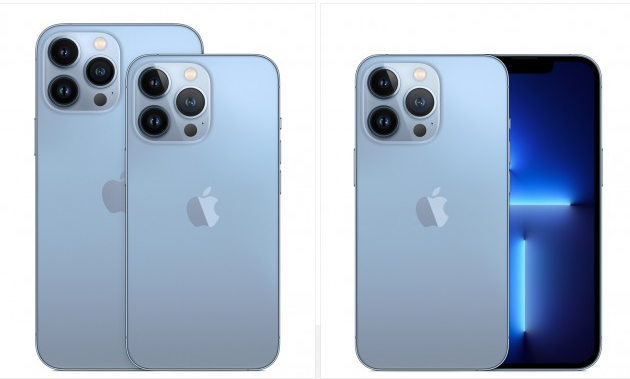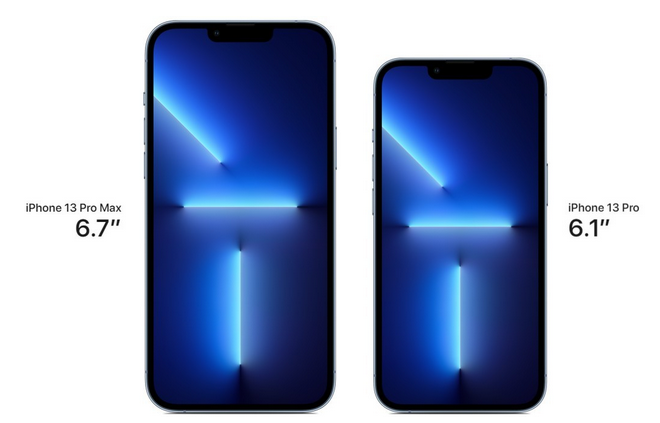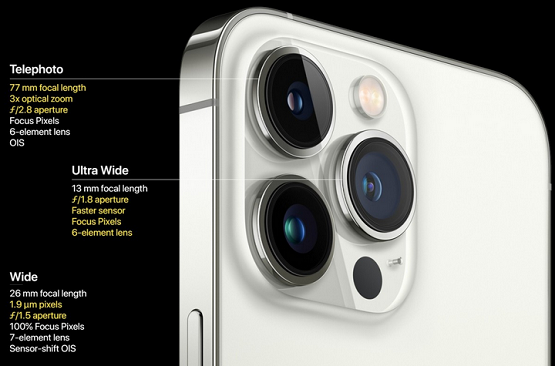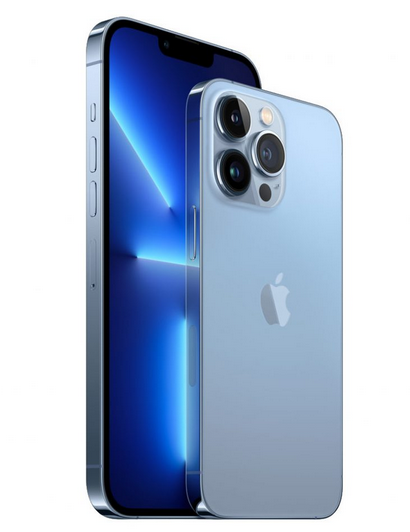Apple also announced the iPhone 13 Pro and 13 Pro Max successor of last year’s iPhone 12 Pro and 12 Pro Max models at the event, with support for 5G, upgraded displays, A15 Bionic chips and bigger batteries.
The both devices feature a 6.1-inch and 6.7-inch OLED Super Retina XDR displays with ProMotion, supporting an adaptive refresh rate from 10Hz to 120Hz.

The both comes with Ceramic Shield protection, A15 Bionic 5nm Chip with new 6-core CPU, 5-core GPU, 16-core Neural Engine and has IP68 water resistance (6 meters for up to 30 minutes) ratings.

Cameras
Next, let’s talk about the camera. Apple stuck with 12MP resolution, but improved the lenses, sensors and image processing.
The main camera sensor has an impressive pixel size of 1.9µm and a brighter aperture of f/1.5. For comparison, the 12 Pro Max had 1.7µm pixels and an f/1.6 lens. This means that in low light the new model can capture up to 2.2x more light.

The telephoto camera has a new 77mm f/2.8 lens, so it offers 3x optical magnification over the main cam. This is up from 65 mm/2.5x lens, though with an f/2.4 aperture.
Next is the ultrawide camera, which also has a better lens – a 6-element f/1.8 one with autofocus to be precise. This is compared to the f/2.4 lens on last year’s Pros, which results in an up to 92% more light hitting the sensor. And a new trick – the autofocus allows the ultrawide module to double as a macro camera. All cameras on the Pro models support Night mode, even the telephoto one.
Highlight Specification of Apple iPhone 13 Pro, and iPhone 13 Pro Max
Display:
iPhone 13 Pro- 6.1-inch (2532×1170 pixels) OLED 460ppi Super Retina XDR display with ProMotion with adaptive refresh rates up to 120Hz, 1000 nits brightness, up to 1200 nits brightness, HDR, Ceramic Shield protection
iPhone 13 Pro Max -6.7-inch (2778×1284 pixels) OLED 458ppi Super Retina XDR display with ProMotion with adaptive refresh rates up to 120Hz, 1000 nits brightness, up to 1200 nits brightness, Ceramic Shield protection
Chipset:
Six-Core A15 (2 performance and 4 efficiency cores) Bionic 5nm chip with 64-bit architecture, 5‑core GPU, 16‑core Neural Engine
Storage:
128GB,256GB, 512GB and 1TB storage options
Operating System: iOS 15
Water and dust resistant (IP68)
SIM: Dual SIM (nano + eSIM)
Camera:
12MP wide-angle (f/1.5) camera, 7P lens, Sensor‑shift optical image stabilisation, True Tone flash, HDR video recording with Dolby Vision at 4K 60 fps, Slo‑mo 1080p at 240fps, 12MP 120° Ultra Wide (f/1.8) camera, 5P lens, 12MP Telephoto camera with f/2.8 aperture with 3x optical zoom for a total 6x optical zoom range, Night mode portraits enabled by LiDAR Scanner
12MP TrueDepth front camera with f/2.2 aperture, Retina Flash, 4K video recording at 60 fps, Slo‑mo 1080p at 120fps

Dimension:
iPhone 13 Pro dimensions: 146.7 ×71.5×7.65mm; Weight: 203grams
iPhone 13 Pro Max dimensions: 160.8 ×78.1×7.65mm; Weight: 238grams
TrueDepth camera for FaceID facial recognition, Stereo speakers
Network:
5G (sub‑6 GHz), Gigabit-class LTE, 802.11ax Wi‑Fi 6 with 2×2 MIMO, Bluetooth 5.0, Ultra Wideband chip for spatial awareness, NFC with reader mode, GPS with GLONASS
Battery:
Built-in rechargeable lithium-ion battery with MagSafe wireless charging, fast charging, up to 22 hours (iPhone 13 Pro) / 28 hours (iPhone 13 Pro Max) of video playback
Pricing
You will be able to pre-order the new iPhones starting this Friday, the first units will be available on September 24. The iPhone 13 Pro starts at $1,000, the iPhone 13 Pro Max at $1,100.

I have a feeling that mobile phones will replace digital camera real soon